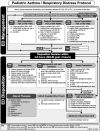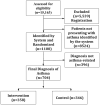An asthma management system in a pediatric emergency department
- PMID: 23218449
- PMCID: PMC3646328
- DOI: 10.1016/j.ijmedinf.2012.11.006
An asthma management system in a pediatric emergency department
Abstract
Introduction: Pediatric asthma exacerbations account for >1.8 million emergency department (ED) visits annually. Asthma guidelines are intended to guide time-dependent treatment decisions that improve clinical outcomes; however, guideline adherence is inadequate. We examined whether an automatic disease detection system increases clinicians' use of paper-based guidelines and decreases time to a disposition decision.
Methods: We evaluated a computerized asthma detection system that triggered NHLBI-adopted, evidence-based practice to improve care in an urban, tertiary care pediatric ED in a 3-month (7/09-9/09) prospective, randomized controlled trial. A probabilistic system screened all ED patients for acute asthma. For intervention patients, the system generated the asthma protocol at triage for intervention patients to guide early treatment initiation, while clinicians followed standard processes for control patients. The primary outcome measures included time to patient disposition.
Results: The system identified 1100 patients with asthma exacerbations, of which 704 had a final asthma diagnosis determined by a physician-established reference standard. The positive predictive value for the probabilistic system was 65%. The median time to disposition decision did not differ among the intervention (289 min; IQR = (184, 375)) and control group (288 min; IQR = (185, 375)) (p=0.21). The hospital admission rate was unchanged between intervention (37%) and control groups (35%) (p = 0.545). ED length of stay did not differ among the intervention (331 min; IQR = (226, 581)) and control group (331 min; IQR = (222, 516)) (p = 0.568).
Conclusion: Despite a high level of support from the ED leadership and staff, a focused education effort, and implementation of an automated disease detection, the use of the paper-based asthma protocol remained low and time to patient disposition did not change.
Copyright © 2012 Elsevier Ireland Ltd. All rights reserved.
Conflict of interest statement
Figures
Similar articles
-
Implementation and evaluation of an integrated computerized asthma management system in a pediatric emergency department: a randomized clinical trial.Int J Med Inform. 2014 Nov;83(11):805-13. doi: 10.1016/j.ijmedinf.2014.07.008. Epub 2014 Aug 8. Int J Med Inform. 2014. PMID: 25174321 Free PMC article. Clinical Trial.
-
Can an evidence-based guideline reminder card improve asthma management in the emergency department?Respir Med. 2010 Sep;104(9):1263-70. doi: 10.1016/j.rmed.2010.03.028. Respir Med. 2010. PMID: 20434896 Free PMC article.
-
Development of an asthma management system in a pediatric emergency department.AMIA Annu Symp Proc. 2009 Nov 14;2009:142-6. AMIA Annu Symp Proc. 2009. PMID: 20351838 Free PMC article.
-
Asthma treatment protocols in the emergency department: are they effective?J Asthma. 2007 May;44(4):243-8. doi: 10.1080/02770900701246691. J Asthma. 2007. PMID: 17530519 Review.
-
Caseworker-assigned discharge plans to prevent hospital readmission for acute exacerbations in children with chronic respiratory illness.Cochrane Database Syst Rev. 2018 Nov 2;11(11):CD012315. doi: 10.1002/14651858.CD012315.pub2. Cochrane Database Syst Rev. 2018. PMID: 30387126 Free PMC article.
Cited by
-
The role of information systems in emergency department decision-making-a literature review.J Am Med Inform Assoc. 2024 Jun 20;31(7):1608-1621. doi: 10.1093/jamia/ocae096. J Am Med Inform Assoc. 2024. PMID: 38781289 Free PMC article.
-
The use of computerized clinical decision support systems in emergency care: a substantive review of the literature.J Am Med Inform Assoc. 2017 May 1;24(3):655-668. doi: 10.1093/jamia/ocw151. J Am Med Inform Assoc. 2017. PMID: 28031285 Free PMC article. Review.
-
Implementation and evaluation of an integrated computerized asthma management system in a pediatric emergency department: a randomized clinical trial.Int J Med Inform. 2014 Nov;83(11):805-13. doi: 10.1016/j.ijmedinf.2014.07.008. Epub 2014 Aug 8. Int J Med Inform. 2014. PMID: 25174321 Free PMC article. Clinical Trial.
-
Clinical pathway improves pediatrics asthma management in the emergency department and reduces admissions.J Asthma. 2015 Oct;52(8):806-14. doi: 10.3109/02770903.2015.1019086. Epub 2015 May 19. J Asthma. 2015. PMID: 25985707 Free PMC article.
-
Workload and workflow implications associated with the use of electronic clinical decision support tools used by health professionals in general practice: a scoping review.BMC Prim Care. 2023 Jan 20;24(1):23. doi: 10.1186/s12875-023-01973-2. BMC Prim Care. 2023. PMID: 36670354 Free PMC article.
References
-
- [accessed 09.03.09]; http://www.cdc.gov/nchs/FASTATS/asthma.htm.
-
- Akinbami LJ, Moorman JE, Liu X. National health statistics reports; No 32. National Center for Health Statistics; Hyattsville, MD: 2011. Asthma alence, health care use, and mortality: United States, 2005–2009. - PubMed
-
- Akinbami LJ. Advance Data from Vital and Health Statistics; No 381. National Center for Health Statistics; Hyattsville, MD: 2006. The State of Childhood Asthma, United States, 1980–2005. - PubMed
-
- Grimshaw JM, Eccles MP, Walker AE, Thomas RE. Changing physicians' behavior: what works and thoughts on getting more things to work. J Contin Educ Health Prof. 2002;22:237–243. - PubMed
-
- Scribano PV, Lerer T, Kennedy D, Cloutier MM. Provider adherence to a clinical practice guideline for acute asthma in a pediatric emergency department. Acad Emerg Med. 2001;8:1147–1152. - PubMed
Publication types
MeSH terms
Grants and funding
LinkOut - more resources
Full Text Sources
Other Literature Sources
Medical





